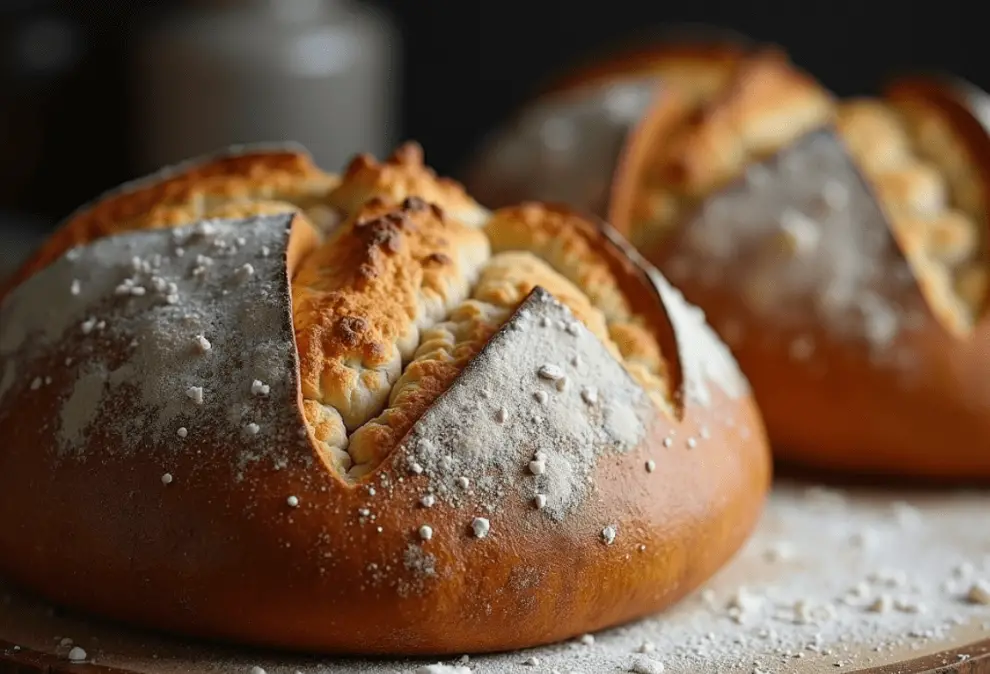Making homemade bread has been a cherished tradition that brings both nourishment and joy to our homes. The art of breadmaking connects us to thousands of years of human history, from ancient Egyptian flatbreads to modern artisanal loaves.
In today’s world, where processed foods dominate our shelves, creating your own bread offers complete control over ingredients and nutrition. The basic principles of breadmaking revolve around four essential elements: flour, water, yeast, and salt.
Understanding how these ingredients work together is key to successful bread baking. When you master these fundamentals, you’ll discover that making bread is like conducting a simple science experiment in your kitchen.
The fermentation process transforms basic ingredients into a living dough that fills your home with an irresistible aroma. Whether you’re a beginner baker or an experienced cook, learning to make bread teaches patience and rewards attention to detail.
The satisfaction of pulling a perfectly baked loaf from your oven makes the effort worthwhile, while the cost savings compared to store-bought bread – often up to 60% less per loaf – make it a practical skill worth developing.
Quality Ingredients Matter
Selection of Flour
Bread flour stands out with its higher protein content of 12-14%, making it ideal for creating chewy, well-structured bread. Hard wheat varieties produce the best yeasted breads, while soft wheat works better for pastries.
Whole wheat flour contains the entire wheat kernel and offers more nutrients and fiber, with a protein content of 13-14%.
Yeast Types
Three main types of baker’s yeast are commonly used:
Active dry yeast requires dissolving in warm water and works best for double-rise recipes
Instant yeast, also called bread machine yeast, offers better shelf stability
Fresh yeast provides the most natural fermentation
The fermentation process varies by yeast type, with active dry yeast taking longer but producing more complex flavors.
Water Quality
Water quality significantly impacts bread’s texture and taste. Medium-hard water produces superior bread compared to other types. The ideal pH level should be between 5-6 for optimal dough development.
Alkaline water (pH > 7.5) can harm gluten formation and slow fermentation. Chlorinated water can actually improve bread quality, especially when using weaker flours.
Optional Additives
Dough improvers enhance bread quality through various mechanisms:
- Ascorbic acid (30-120 ppm) strengthens dough and improves gas retention
- Emulsifiers enhance machinability and extend shelf life
- Vital gluten adds strength and improves texture
Modern bread production often includes dough conditioners to maintain consistent quality, though many bakers now prefer clean label ingredients. Sugar and milk solids can be added to enhance flavor and browning, while fats improve texture and shelf life.
These ingredients work together to create the perfect loaf: flour provides structure, yeast creates rise, water activates proteins, and additives ensure consistency. The key is balancing these elements for optimal results.
Proper Measurement Techniques
Weight vs. Volume
Using a digital scale provides the most accurate measurements for bread baking. While measuring cups are common, they can lead to significant variations – up to 20% difference in ingredient amounts.
For professional results, weight measurements are essential as they eliminate inconsistencies caused by different measuring techniques.
Temperature Control
Temperature management is crucial for proper ingredient interaction and fermentation. Keep these key points in mind:
Use room temperature ingredients for better incorporation
Monitor dough temperature during mixing and proofing
Maintain consistent ambient temperature during the baking process
Ingredient Ratios
The success of bread baking depends on precise ingredient proportions. Here’s what you need to know:
Basic Bread Formula:
- Flour: 100% (base percentage)
- Water: 60-75%
- Yeast: 1-2%
- Salt: 1.8-2%
Measurement Precision
For consistent results:
- Use a kitchen scale that measures to 0.1g precision
- Weigh containers first and use the tare function
- Measure liquids at eye level for accuracy
Environmental Factors
Humidity and altitude can affect measurements:
Flour absorbs moisture from air, affecting weight
High altitude requires adjustment in leavening agents
Temperature variations impact ingredient behavior
Professional bakers measure by weight because the margin of error is much smaller. Even a tenth of a percent difference in crucial ingredients can affect the final product.
For home bakers, investing in a quality digital scale and understanding proper measurement techniques will significantly improve baking results.
Mastering the Kneading Process
Hand Kneading Methods
Two primary kneading techniques help develop the perfect bread structure. The French Fold works best for wet doughs with over 65% hydration, while the Stretch and Fold method suits firmer doughs. For basic bread dough, use the heel of your hand to push forward while folding the dough back with your other hand.
Machine Kneading Guidelines
When using a stand mixer, knead the dough with a dough hook at speed 2 for 2-15 minutes until smooth and elastic. The key is focusing on the dough’s texture rather than timing. Bread machines typically need 10-15 minutes of kneading time for optimal gluten development.
Gluten Development Signs
Several indicators show proper gluten formation:
Visual Cues:
- Smooth surface instead of rough texture
- Dough holds its shape
- Quick spring-back when poked
The Windowpane Test:
Stretch a small portion of dough – properly kneaded dough forms a thin, translucent membrane without breaking. This indicates well-developed gluten networks that will support good oven spring.
Common Issues:
- Under-kneaded dough breaks easily during stretching
- Over-kneaded dough feels tight and tears
Professional Tip: If the dough feels tight during kneading, let it rest for 5 minutes. This allows the gluten strands to relax and prevents over-kneading. The protein molecules in wheat flour combine with water to form elastic gluten strands that give bread its structure.
Remember that kneading time varies based on factors like flour type, hydration level, and mixing method. A well-kneaded dough should feel smooth and slightly tacky but not sticky.
Read More: SimplyCanadian Drink: Elevating the Art of Natural Refreshment
Fermentation Understanding
Primary Fermentation
The fermentation process begins immediately after mixing the dough. During this stage, yeast converts sugars into carbon dioxide and ethanol.
This initial phase, also called bulk fermentation, typically lasts 2-5 hours at temperatures between 74-78°F (23-25°C). The dough undergoes significant changes as organic acids develop, creating both flavor and strength.
Proofing Time
Proofing duration directly impacts bread quality. The optimal proofing period allows for:
- Complete gas production by yeast
- Development of proper gluten structure
- Formation of complex flavor compounds
Too short proofing results in dense bread, while excessive proofing weakens the dough structure and causes collapse. Most doughs require 20-30 minutes at 35°C using a proofing machine, or 60-90 minutes at room temperature.
Environmental Factors
Several key environmental conditions affect fermentation:
Temperature Control
Yeast performs optimally between 25-35°C
Lactic acid bacteria thrive at 18-22°C
Higher temperatures speed up fermentation but risk killing yeast
pH Levels
The ideal pH range is 4.0-5.0 for proper fermentation. Outside this range, unwanted byproducts like acetic acid may form.
Humidity and Air
- Proper humidity prevents dough surface drying
- Aeration affects yeast behavior through the Pasteur effect
- Limited air exposure produces better results than high aeration
The interaction between these factors creates the perfect environment for dough development. Controlling these variables ensures consistent, high-quality bread with proper volume and texture.
Baking Techniques
Oven Preparation
Preheating is crucial for perfect bread. Set your oven to 240°C (460°F) and place a baking stone on the middle rack for 30-60 minutes before baking. For best results, use the bottom heat setting to create even heat distribution throughout the oven.
Temperature Control
Start baking at a higher temperature, then reduce it for optimal results:
- Initial bake: 220-240°C (430-460°F)
- Reduced temperature: 200-220°C (400-430°F)
Different breads require specific temperatures:
- Bread rolls: 220°C for 20 minutes
- Standard loaves (500g-1kg): 200°C for 45 minutes
- Sourdough: 230°C for 10 minutes, then 200°C for 30 minutes
Steam Considerations
Steam plays three critical roles:
- Keeps the crust elastic during initial baking
- Enables proper oven spring
- Creates a shiny, crispy exterior
Steam Methods:
Use a spray bottle with warm water
Place a cast iron pan with boiling water below the bread
Bake in a Dutch oven for natural steam retention
Timing Guidelines
Follow these baking durations:
- 1-pound loaves: 30-35 minutes
- 2-pound loaves: 45-50 minutes
- 3-pound loaves: 60 minutes
For Dutch oven baking:
- Bake covered for 35 minutes
- Remove lid and bake additional 15-20 minutes
Remember to check for doneness by tapping the bottom – it should sound hollow. The internal temperature should reach 205-210°F for most breads.
Conclusion
Making great bread requires mastering several key elements: precise ingredient measurements, proper kneading techniques, and careful attention to fermentation and baking conditions.
Common challenges like dense texture or uneven crusts can be avoided by understanding how temperature, humidity, and timing affect your bread. When troubleshooting, remember that under-proofed bread will be dense and heavy, while over-proofed bread collapses during baking.
The journey to perfect bread takes practice – each loaf teaches valuable lessons about dough handling and timing. Start with simple recipes and gradually work up to more complex ones. Keep a baking journal to track your progress and adjustments.
With dedication and attention to detail, you’ll develop an intuitive understanding of the breadmaking process. Remember that even professional bakers spent years perfecting their craft, so embrace each attempt as a learning opportunity.
Your skills will improve with every batch, leading to consistently delicious, homemade bread that rivals any bakery’s offerings.


